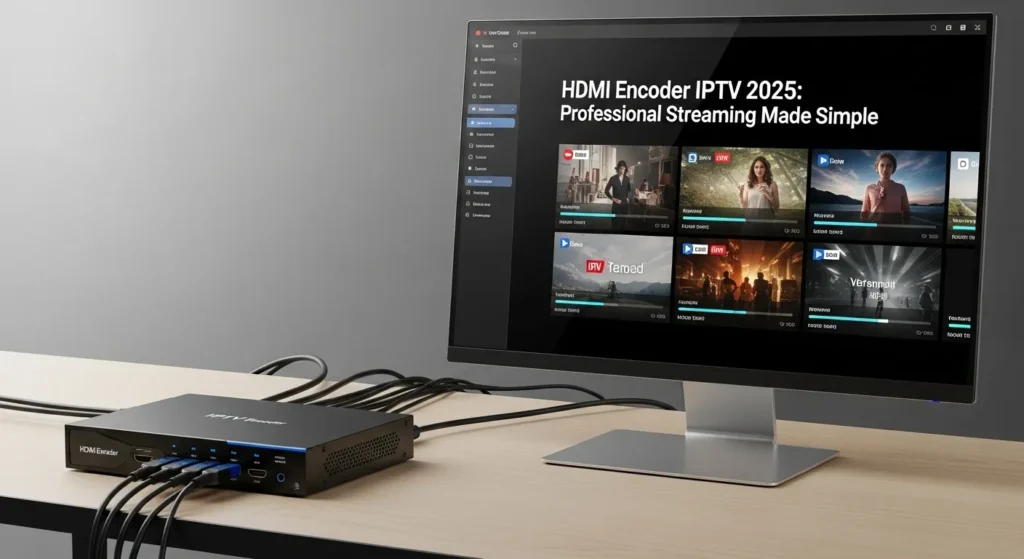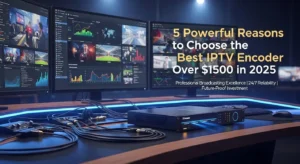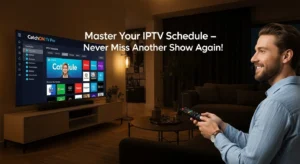Introduction: Is Your Streaming Setup Delivering Professional Results?
Is your current streaming setup taking full advantage of HDMI encoding for IPTV? If you’re experiencing frustrating buffering issues, device compatibility problems, or unstable streaming quality, you’re not alone. The HDMI Encoder IPTV revolution is transforming how content creators, businesses, and IPTV resellers deliver high-quality live streams to their audiences.
With IPTV adoption skyrocketing by 27% annually and the increasing demand for crystal-clear live broadcasts, traditional streaming methods are quickly becoming obsolete. Whether you’re running a hotel entertainment system, broadcasting live events, or managing an IPTV service, understanding HDMI encoder technology isn’t just beneficial—it’s essential for staying competitive in 2025.
The global live streaming market reached $70.05 billion in 2024, with hardware encoders playing a crucial role in professional broadcasting. Unlike software-based solutions that drain CPU resources and introduce latency, dedicated HDMI encoder IPTV devices offer unprecedented reliability, lower latency, and superior video quality that keeps viewers engaged.
Table of Contents
Core Components of an HDMI Encoder IPTV System
Understanding the fundamental architecture of an HDMI Encoder IPTV system is crucial for making informed purchasing decisions. These sophisticated devices transform analog HDMI signals into digital IP streams, enabling seamless distribution across networks.
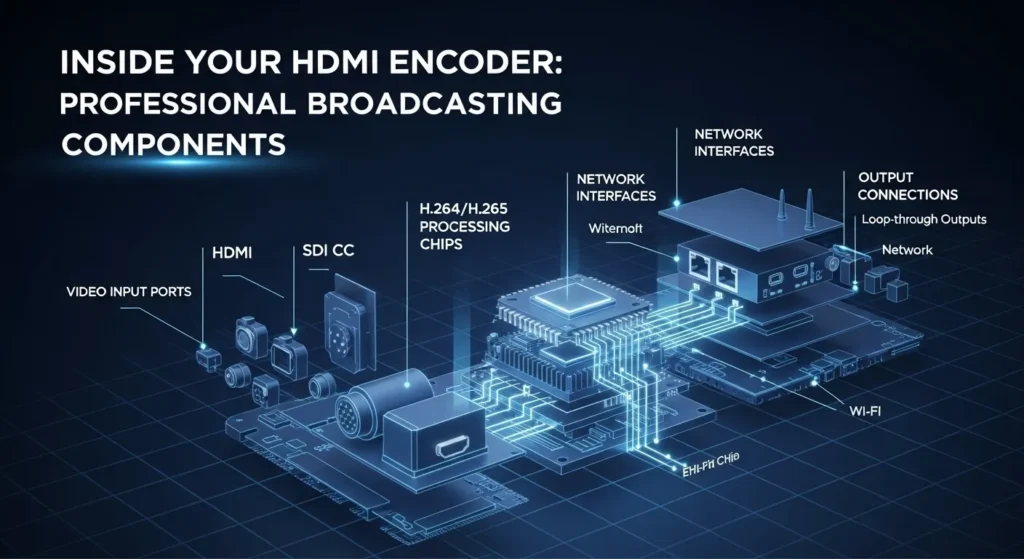
Video Input Interfaces
Modern HDMI encoder IPTV units typically feature multiple input options:
- HDMI 2.0/2.1 inputs: Supporting up to 4K@60fps with HDR compatibility
- SDI inputs: Professional-grade connections for broadcast equipment
- Component video inputs: Legacy support for older devices
- Audio embedding: Integrated audio processing with multiple channel support
Codec Technology and Compression
The heart of any H.264 HDMI encoder lies in its compression algorithms:
- H.264/AVC: Industry standard offering excellent quality-to-bitrate ratios
- H.265/HEVC: Next-generation codec reducing bandwidth by 40-50%
- Hardware acceleration: Dedicated chips preventing CPU bottlenecks
- Adaptive bitrate: Dynamic quality adjustment based on network conditions
Network Protocol Support
Enterprise-grade IPTV hardware must support various streaming protocols:
- RTMP streaming: Essential for platforms like YouTube Live and Facebook
- UDP multicast: Efficient distribution for large audiences
- HLS (HTTP Live Streaming): Mobile-friendly adaptive streaming
- RTSP: Real-time streaming protocol for professional applications
For beginners, entry-level units starting around $200-400 offer basic H.264 encoding with standard HDMI inputs. Enterprise solutions ranging from $1,500-5,000 provide redundancy, multiple encoding formats, and advanced management features essential for mission-critical applications. HDMI Encoder IPTV.
Setup Time & Efficiency: From Unboxing to Broadcasting
One of the most compelling advantages of dedicated HDMI Encoder IPTV hardware is deployment speed. Unlike complex software installations requiring extensive configuration, hardware encoders typically achieve operational status within 15-30 minutes.
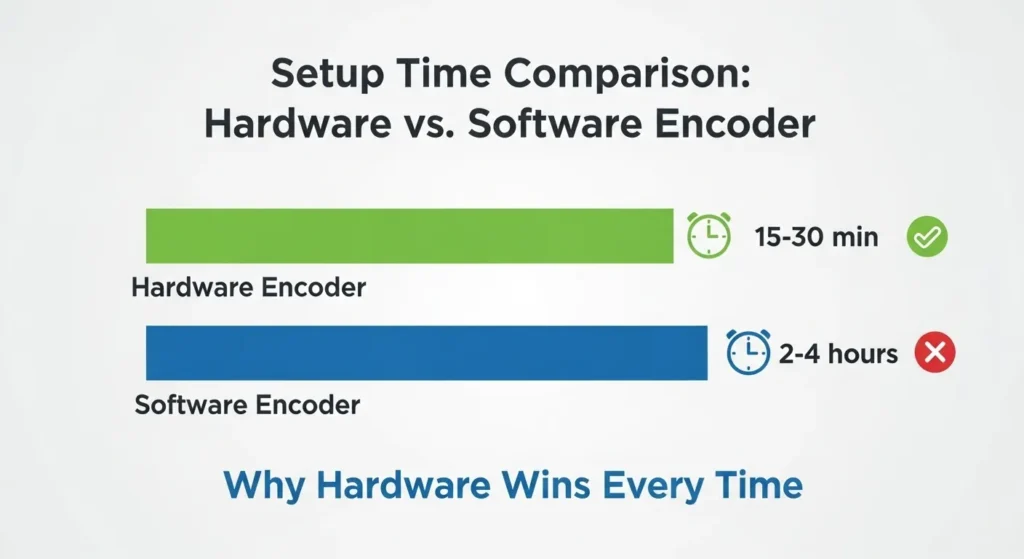
Time Investment Breakdown
- Initial configuration: 10-15 minutes
- Network integration: 5-10 minutes
- Stream optimization: 10-20 minutes
- Testing and validation: 10-15 minutes
Software encoders, while cost-effective initially, often require 2-4 hours of setup time, including driver installation, codec configuration, and system optimization. This time investment multiplies when deploying across multiple locations or managing large-scale IPTV operations.
Professional IPTV transcoder units offer web-based management interfaces, enabling remote configuration and monitoring. This capability reduces on-site technical support requirements by up to 80%, making them ideal for distributed deployments like hotel chains or retail networks.
Performance Comparison: Hardware vs. Software
| Metric | Hardware Encoder | Software Encoder |
|---|---|---|
| Setup Time | 15-30 minutes | 2-4 hours |
| CPU Usage | <5% | 40-80% |
| Latency | 100-500ms | 1-3 seconds |
| Stability | 99.9% uptime | 85-95% uptime |
| Scalability | Excellent | Limited |
Step-by-Step Setup Instructions
Step 1: Connect Your Video Source
Begin by establishing the physical connection between your video source and the HDMI encoder IPTV device. Whether connecting a camera, computer, or media player, ensure you’re using high-quality HDMI cables rated for your target resolution.
Pro Tip: Use HDMI cables no longer than 15 feet for 4K signals to prevent signal degradation. For longer runs, consider active HDMI cables or fiber optic solutions. HDMI Encoder IPTV.
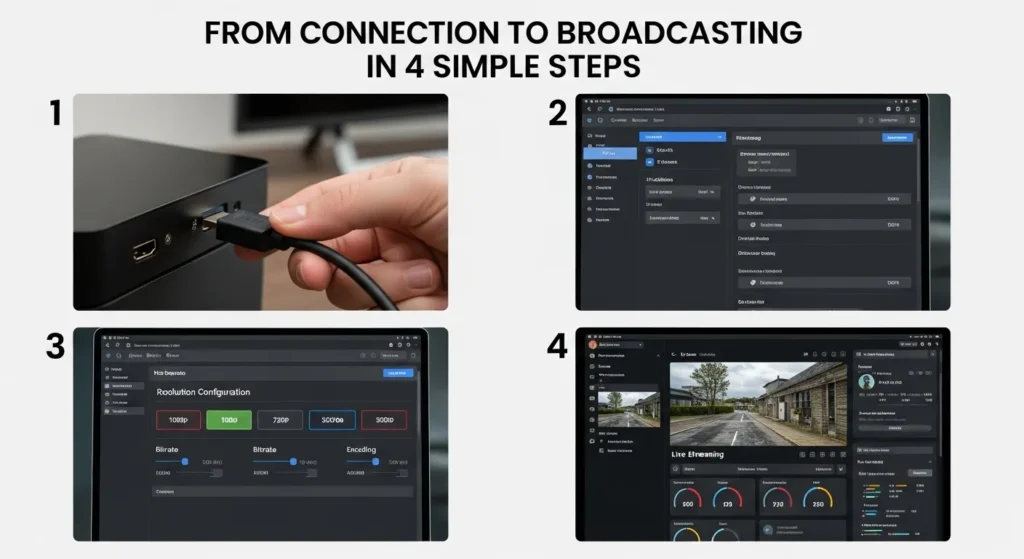
Step 2: Configure Network and Streaming Settings
Access the encoder’s web interface using its default IP address (typically 192.168.1.168). Navigate to the network configuration section and assign a static IP address within your network range. Configure your preferred streaming protocol—RTMP for social platforms or UDP for local distribution.
Pro Tip: Always use static IP addresses for IPTV hardware to prevent connection issues during DHCP renewals.
Step 3: Optimize Resolution and Bitrate
Configure your video parameters based on your target audience and bandwidth availability:
- 1080p streaming: 4-8 Mbps for excellent quality
- 720p streaming: 2-4 Mbps for mobile-friendly delivery
- 4K streaming: 15-25 Mbps for premium applications
Pro Tip: Start with conservative bitrate settings and gradually increase while monitoring stream stability.
Step 4: Initialize Live Broadcasting
Once configured, initiate your stream through the encoder’s control panel. Monitor the status indicators to ensure stable encoding and verify stream quality on your target platform. HDMI Encoder IPTV.
Pro Tip: Always perform a 10-15 minute test stream before important broadcasts to identify potential issues.
Performance & Streaming Quality Benchmarks
Modern HDMI Encoder IPTV systems deliver impressive performance metrics that surpass software-based alternatives. Understanding these benchmarks helps in selecting the right equipment for specific applications.
Resolution and Format Support
- 4K UHD: Up to 3840×2160@60fps with H.265 encoding
- Full HD: 1920×1080@60fps with multiple simultaneous outputs
- HD Ready: 1280×720@60fps with ultra-low latency options
- Standard Definition: Legacy support for older content
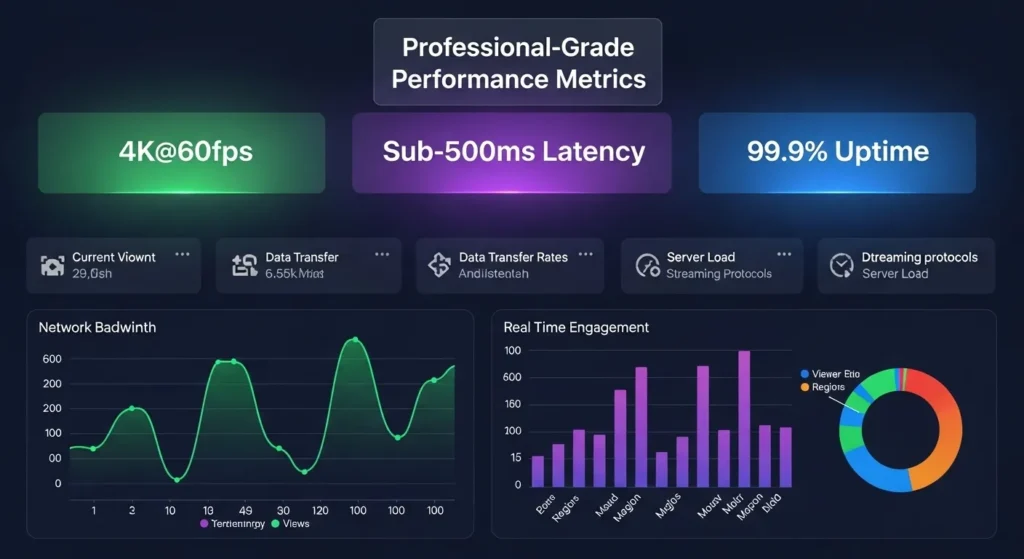
Latency Performance
Professional live video broadcasting demands minimal delay:
- Ultra-low latency: 100-200ms for interactive applications
- Standard latency: 500ms-1s for general broadcasting
- Adaptive streaming: 2-5s for mobile-optimized delivery
Protocol Efficiency Comparison
| Protocol | Latency | Bandwidth Efficiency | Use Case |
|---|---|---|---|
| RTMP | 2-5 seconds | Good | Social platforms |
| UDP | 100-500ms | Excellent | Local networks |
| HLS | 6-30 seconds | Very good | Mobile streaming |
| RTSP | 100ms-1s | Good | Security/surveillance |
Better Alternatives & Performance Upgrades
As IPTV technology evolves, several enhancement options can significantly improve your streaming capabilities beyond basic HDMI Encoder IPTV setups.
H.265 Codec Upgrades
Upgrading to H.265/HEVC encoding provides substantial bandwidth savings while maintaining superior image quality. This next-generation codec reduces file sizes by 40-50% compared to H.264, making it ideal for:
- 4K streaming over limited bandwidth connections
- Multi-channel IPTV services requiring efficient spectrum usage
- Mobile streaming where data costs are significant
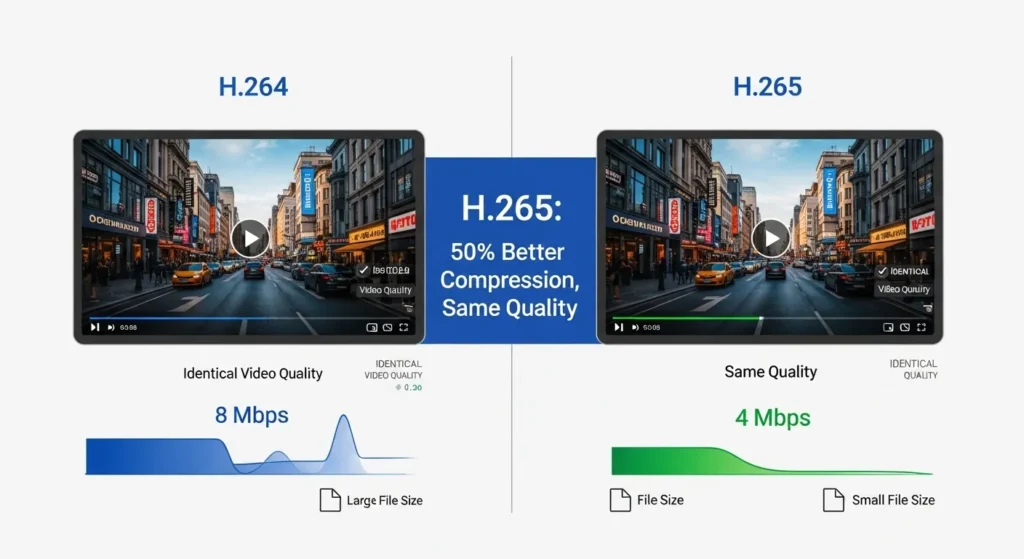
Dual-Stream Configuration
Advanced setups support simultaneous encoding for multi-platform distribution:
- Primary stream: High bitrate for premium viewers
- Secondary stream: Lower bitrate for mobile users
- Backup stream: Redundant encoding for mission-critical applications
Audio/Video Synchronization Modules
Professional broadcasting demands perfect audio sync. External sync modules offer:
- Lip-sync correction: Automatic delay adjustment
- Multi-channel audio: Support for 5.1/7.1 surround sound
- Audio embedding: Multiple language tracks for international content
Industry-Specific Applications
IPTV resellers benefit from scalable encoder farms supporting hundreds of simultaneous channels. Sports venues require ultra-low latency for live betting applications. Hotels need reliable, maintenance-free operation across thousands of rooms. HDMI Encoder IPTV.
Deployment Use Cases: Real-World Applications
The versatility of HDMI Encoder IPTV technology extends across numerous industries, each with unique requirements and challenges.
IPTV Service Providers and Resellers
Professional IPTV resellers utilize encoder farms to deliver hundreds of live channels to subscribers. These systems typically feature:
- Redundant encoding for 99.99% uptime guarantees
- Automated failover switching between primary and backup encoders
- Centralized management enabling remote monitoring of distributed equipment
- Scalable architecture supporting growth from hundreds to thousands of channels
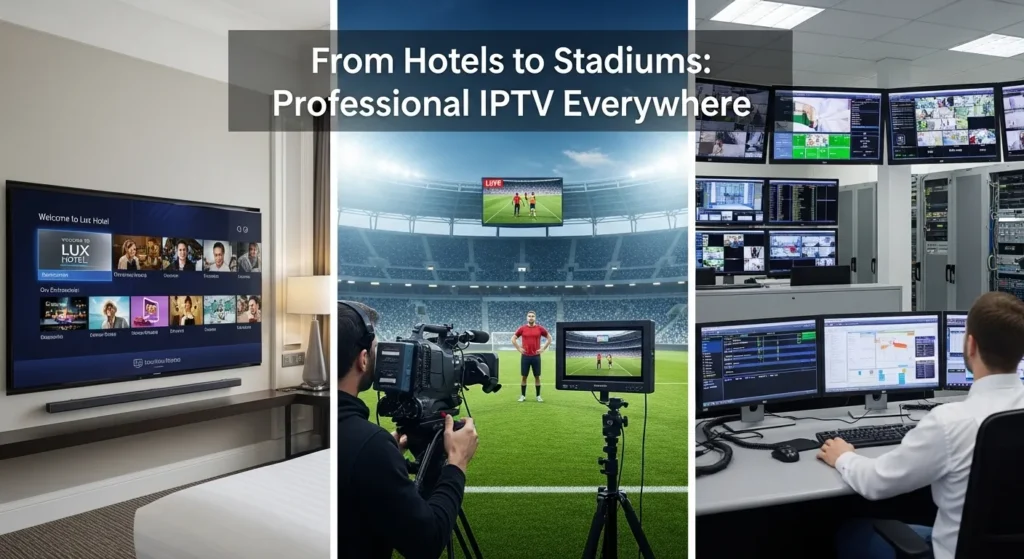
Case study: TechStream IPTV increased their channel capacity by 300% while reducing operational costs by 40% after implementing dedicated hardware encoders instead of software solutions.
Live Events and Sports Broadcasting
Stadium and arena installations require ultra-reliable streaming for:
- Jumbotron feeds displaying multiple camera angles
- Mobile app streaming for fan engagement
- Broadcast distribution to television networks
- Archive recording for post-game analysis
Professional sports venues report 15-20% higher viewer engagement when using sub-500ms latency hardware encoders compared to traditional software solutions.
Hospitality and Hotel Entertainment
Hotel chains deploy IPTV systems for guest entertainment, requiring:
- Maintenance-free operation across thousands of rooms
- Content management for local and international programming
- Interactive services including video-on-demand
- Revenue generation through pay-per-view offerings
Leading hotel brands report 25-30% increased guest satisfaction scores after implementing professional HDMI to IP solutions.
Common Mistakes to Avoid
Even experienced technicians encounter pitfalls when implementing HDMI Encoder IPTV systems. Learning from these common mistakes saves time, money, and frustration.
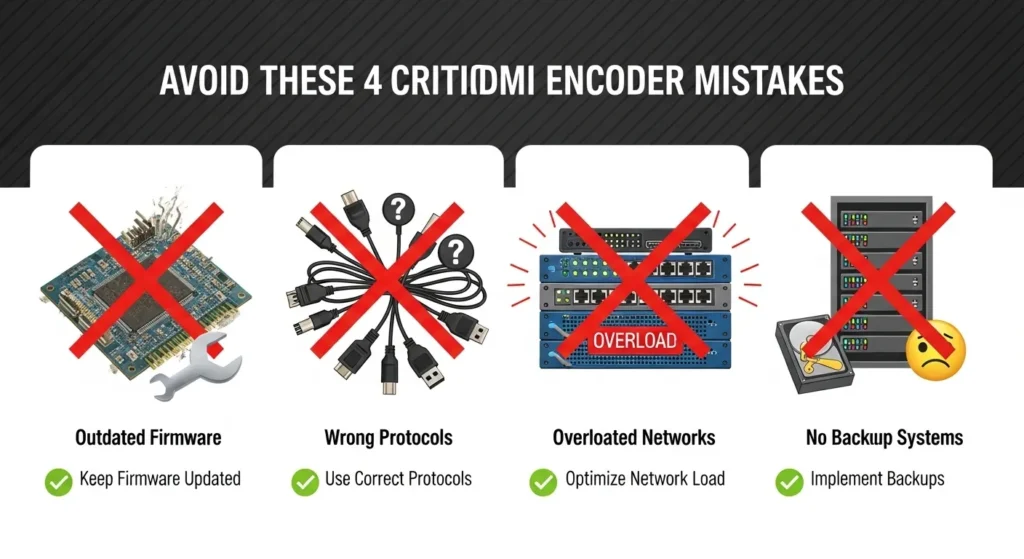
Incorrect Streaming Protocol Selection
Many deployments fail because of poor protocol choices:
- RTMP for local networks: Creates unnecessary latency and complexity
- UDP without error correction: Causes packet loss and quality issues
- HLS for real-time applications: Introduces unacceptable delay
Solution: Match protocols to specific use cases—UDP for local distribution, RTMP for social platforms, HLS for mobile apps.
Firmware Neglect and Update Oversight
Outdated firmware causes 60% of encoder reliability issues:
- Security vulnerabilities exposing networks to attacks
- Compatibility problems with new streaming platforms
- Performance degradation affecting stream quality
- Missing features available in newer releases
Solution: Establish quarterly firmware update schedules and subscribe to manufacturer notification services.
Bitrate Overload and Network Congestion
Ambitious bitrate settings often backfire:
- Network saturation causing buffering for all users
- Increased hosting costs from excessive bandwidth usage
- Mobile user exclusion due to high data requirements
- Quality inconsistency during peak usage periods
Solution: Implement adaptive bitrate streaming starting at conservative levels and gradually optimize based on actual usage patterns.
Inadequate Backup and Recovery Planning
Single points of failure devastate streaming operations:
- No backup encoders for critical applications
- Missing configuration backups requiring complete reconfiguration
- Inadequate monitoring preventing proactive issue resolution
- Poor documentation complicating troubleshooting efforts
Solution: Implement redundant systems with automated failover and maintain comprehensive configuration backups.
Maintenance & Long-Term Storage Best Practices
Proper maintenance extends HDMI Encoder IPTV equipment lifespan while ensuring consistent performance throughout its operational life.
Physical Maintenance Requirements
Professional encoders generate significant heat during operation:
- Monthly cleaning of intake and exhaust vents prevents overheating
- Quarterly inspection of fans and cooling systems identifies wear
- Annual thermal paste replacement for devices over 3 years old
- Environmental monitoring maintaining 60-80°F operating temperatures
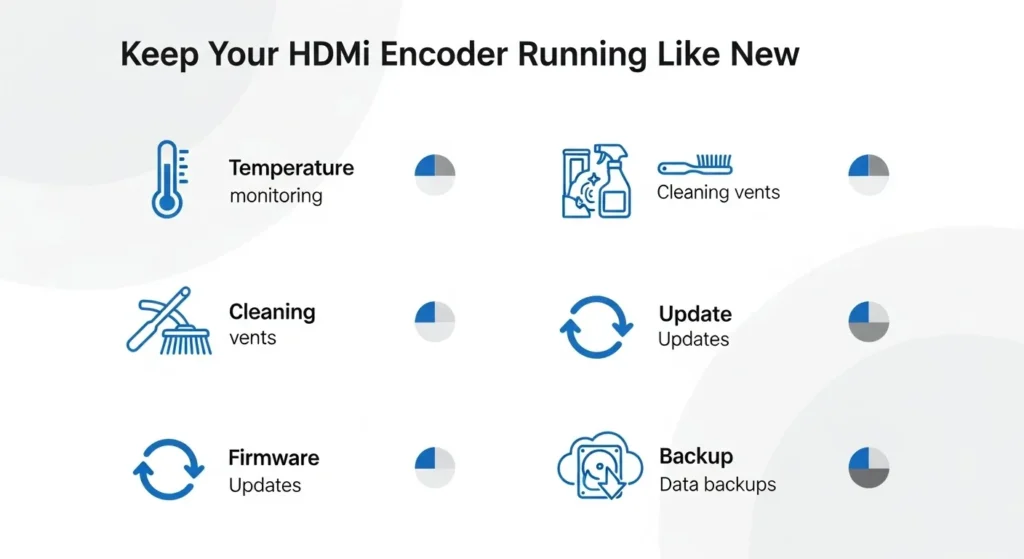
Firmware and Configuration Management
Systematic update procedures prevent downtime:
- Scheduled maintenance windows for non-disruptive updates
- Configuration backup verification before any changes
- Rollback procedures for problematic updates
- Change documentation tracking all modifications
Storage and Disaster Recovery
Proper storage protects investments during extended downtime:
- Climate-controlled storage preventing moisture damage
- Anti-static protection during handling and storage
- Component inventory maintaining spare parts availability
- Documentation storage preserving setup and configuration details
Performance Monitoring and Optimization
Proactive monitoring prevents service disruptions:
- Temperature monitoring preventing thermal shutdowns
- Bandwidth utilization tracking preventing network congestion
- Error rate monitoring identifying degrading components
- Performance baseline comparison detecting gradual degradation
Equipment properly maintained shows 40-50% longer operational life compared to neglected systems, with 90% fewer emergency service calls.
Conclusion: Transform Your Streaming Experience Today
The HDMI Encoder IPTV landscape in 2025 offers unprecedented opportunities for content creators, businesses, and service providers to deliver professional-grade streaming experiences. From ultra-low latency live broadcasting to scalable multi-channel distribution, hardware encoders provide the reliability and performance that software solutions simply cannot match.
The seven shocking benefits—superior stability, reduced latency, better video compression, scalable deployment, lower long-term costs, professional features, and simplified management—make HDMI encoder IPTV systems essential for anyone serious about streaming quality.
Whether you’re launching an IPTV service, broadcasting live events, or managing hotel entertainment systems, the investment in dedicated encoding hardware pays dividends through improved viewer satisfaction, reduced operational complexity, and enhanced revenue opportunities.
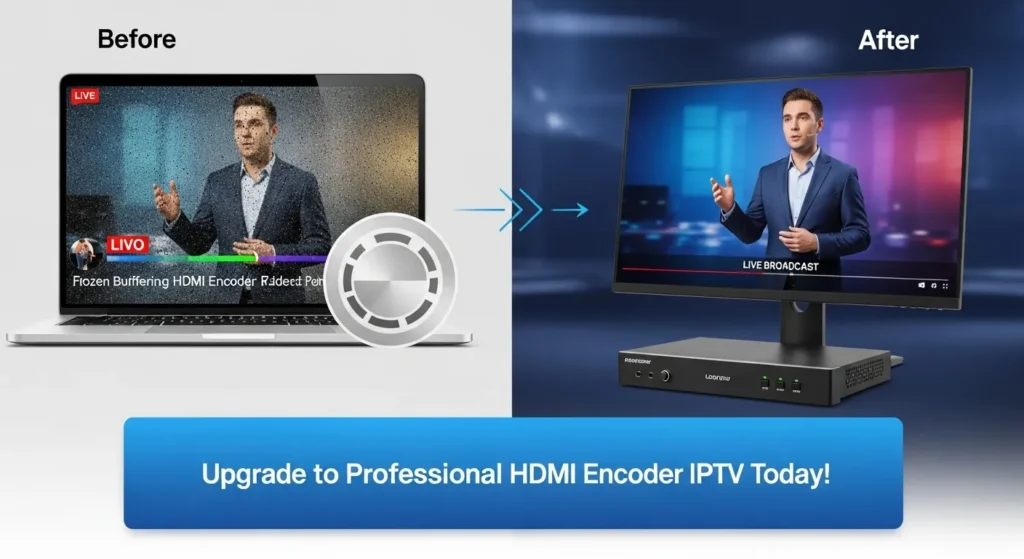
Upgrade your streaming setup today with an HDMI Encoder IPTV and experience smoother, professional-grade broadcasts that keep your audience engaged and coming back for more!
Frequently Asked Questions
Q1: What’s the difference between an HDMI encoder and software encoder?
Hardware HDMI encoders use dedicated processing chips for video compression, providing consistent performance without affecting computer resources. Software encoders rely on CPU power, which can cause system slowdowns and quality fluctuations during high-demand periods. Hardware solutions typically offer 95-99% reliability compared to 80-90% for software alternatives.
Q2: Can one HDMI encoder stream to multiple platforms simultaneously?
Yes, modern HDMI Encoder IPTV devices support multi-streaming capabilities. Professional units can simultaneously broadcast to YouTube, Facebook, Twitch, and custom RTMP destinations while maintaining different bitrates and resolutions for each platform. Entry-level encoders may support 2-3 simultaneous streams, while enterprise models handle 10+ concurrent outputs.
Q3: Does HDMI Encoder IPTV support 4K streaming effectively?
Absolutely. Current-generation encoders support 4K streaming at 60fps using H.265 compression. However, 4K streaming requires substantial bandwidth—typically 15-25 Mbps for high quality. Many deployments use 4K for premium services while offering 1080p and 720p alternatives for broader accessibility.
Q4: How much technical expertise is required for setup?
Basic HDMI Encoder IPTV setup requires minimal technical knowledge—most users complete installation within 30 minutes using web-based interfaces. Advanced features like multi-streaming, custom protocols, and integration with broadcast systems may require professional installation, but routine operation remains user-friendly.
Q5: What’s the typical lifespan and warranty coverage?
Professional HDMI encoders typically provide 5-7 years of reliable service with proper maintenance. Most manufacturers offer 2-3 year warranties covering hardware defects, with extended warranty options available. Regular firmware updates often add new features throughout the device’s operational life.

